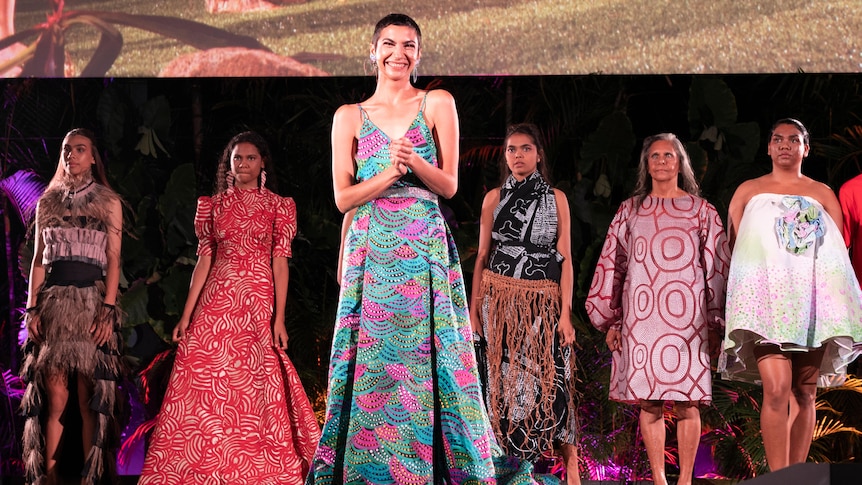First Nations fashion is about much more than just clothes.
Key points:
- The National Indigenous Fashion Awards were held in Darwin last night to recognize First Nations creatives in the fast-growing industry
- Babbara Women’s Center in Arnhem Land and Maningrida artist Esther Yarllarlla were recognized at the awards
- Artists and organizers say the Indigenous fashion industry creates opportunities for economic development and cultural awareness
According to one of the people behind the National Indigenous Fashion Awards, the fast-growing industry is a gateway for greater recognition of First Nations people and culture more broadly.
“When we come together as Australians to make decisions around things like an [Indigenous] voice to parliament … people will have a better understanding,” Darwin Aboriginal Art Fair Foundation Chair, Franchesca Cubillo, said.
“Because they’ve had those conversations with First Nations people, because they’ve bought those textiles or they’ve seen paintings or fashion.
The third annual NIFAs — which see Indigenous designers and artists from all over the country recognized for their work — were held in Darwin last night.
“It is so overwhelming to have First Nations people coming from all regions of Australia coming to Larrakia Country,” Ms Cubillo — who is a Larrakia, Bardi, Wardaman and Yanuwa woman — said.
She said the awards provided a platform for First Nations artists to showcase their work to a broader audience and provided economic opportunities for Indigenous communities.
“It is black excellence, it is unbelievably empowering and the lovely thing is there’s … amazing economic return that happens as well,” Ms Cubillo said.
“It means that our First Nations creatives have really clear pathways to engage in what is the Australian Fashion Industry, it’s a $27 billion industry.
“Our aesthetic is ancient and tens of thousands of years in the making, but equally so cutting edge … that we are seeing it gracing catwalks … in Milan, London and in Europe, in Asia”
Arnhem Land artists at the forefront of fashion
Kunibidji artist Esther Yarllarlla won the Traditional Adornment Award for her Mokko (bark skirt) made with traditional weaving and knotting techniques.
Hailing from the Arnhem Land community of Maningrida, her work is part of a cultural practice she learned from her mother and is now passing on to the next generation.
“I was starting from 10 years old, right back,” she said.
“I’m teaching my grandkids right now. Telling stories to them.”
She brought all of the artists from the Babbara Women’s Center — the arts center she works out of — onto the stage to receive her award.
“I’m happy but I was shaking — it was the first time for me to come [to the awards],” she said.
“I told them ‘we go together’.”
Originally established in 1983 as a women’s refuge, the Centre’s textile production arm, Babbara Designs, was also recognized at the awards as one of Australia’s oldest continuously operating Indigenous textile enterprises.
Artists from the Center have gone on to have their designs featured at an exhibition in Paris.
“We’ve gained such an incredible audience from social media and the Babbara Designs side of our business has just given our artists such incredible opportunities for travel and financial independence,” Babbara Women’s Center Assistant Manager Ziian Carey said.
“It’s giving a platform for our artists to tell their stories, tell their culture.”
Industry expected to grow, become ‘on par’ with Indigenous art
Wiradjuri designer and Founder of Melbourne-based fashion company Ngali, Denni Francisco, won the Fashion Designer Award for her collection designed in collaboration with Gija artist Lindsay Malay.
This is the second year Ms Francisco has won the award, with her win last year allowing her to receive mentoring by Country Road.
She said there has been a massive “elevation” of First Nations fashion in recent years.
“Not that it wasn’t there before, but there is more visibility of it now,” she said.
“With that visibility comes more inspiration.”
Ms Cubillo said the future of Indigenous fashion is bright.
“We will find more and more First Nations designs and fashion appearing in more and more front windows at David Jones and Myer and major department stores,” she said.
“First Nations textile design and fashion will be an industry on the same par as Indigenous art.”
.
